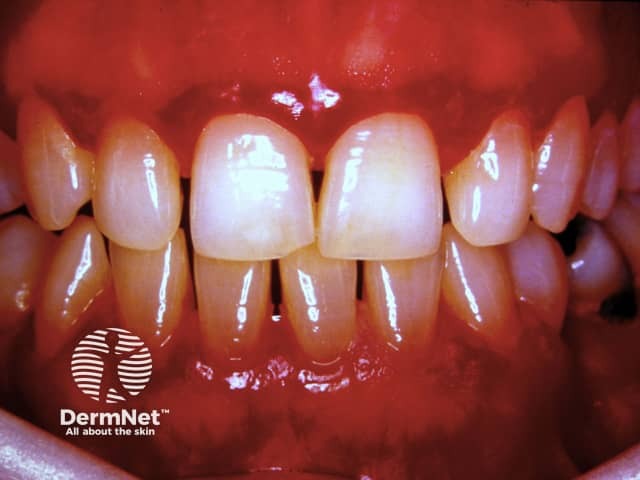Main menu
Common skin conditions

NEWS
Join DermNet PRO
Read more
Quick links
Cutaneous adverse effects of anticonvulsant drugs — extra information
Cutaneous adverse effects of anticonvulsant drugs
Author: Matthew Scorer, Medical Student, Peninsula Medical School, United Kingdom, 2011.
Introduction Anticonvulsant drugs Adverse cutaneous reactions Genetic predisposition
Introduction
Many drugs can cause cutaneous (skin) side effects. The severity of the symptoms can range from a mild rash to life-threatening conditions causing skin failure and death. Certain groups of drugs are known to cause frequent, specific, or serious skin reactions. The anticonvulsant or antiepileptic drugs are one such group of drugs, some of which have notable side effects on the skin.
Recognising the side effects that involve the skin is important, as prompt withdrawal of the drug can prevent worsening of symptoms caused by the drug. A decision may have to be made in a patient who has suffered a drug eruption whether to continue an important drug that might have caused the reaction or switch to an alternative drug.
When confronted by a new skin rash in a patient, a full drug history is paramount and should include prescribed, over-the-counter, and alternative medicines the patient is taking so that drug eruptions can be considered or ruled out.
Anticonvulsant drugs
Anticonvulsant drugs, also known as antiepileptic or antiseizure drugs, are a diverse group of medications that are commonly used in the treatment of epilepsy and seizures, and less commonly for other conditions such as trigeminal neuralgia and bipolar disorder. They work by reducing the excessive firing of neurons that happens in a seizure.
Adverse cutaneous reactions
Types of skin reactions to anticonvulsant drugs |
|
|---|---|
Reaction |
Symptoms |
|
|
|
|
Target (iris) shaped lesions May involve mucous membranes Self-limiting and usually resolves without complications |
|
Usually develops within the first week of taking the drug Serious and potentially fatal skin reaction with sheet-like skin and mucosal loss Rare immune-complex-mediated hypersensitivity |
|
Anticonvulsant hypersensitivity syndrome |
Symptoms usually develop 2-6 weeks after starting the drug but may happen at any time Symptoms include the triad of fever, generalised maculopapular rash, and lymphadenopathy The rash spreads to varying degrees over the trunk and extremities Can involve internal organs such as the kidneys, liver, central nervous system and bone marrow |

Morbilliform eruption

Urticaria

Erythema multiforme

Toxic epidermal necrolysis

Purpuric eruption

Gingival hyperplasia
Specific reactions to anticonvulsant drugs |
||
|---|---|---|
Drug |
Skin reaction |
Notes |
Carbamazepine |
Cutaneous side effects are the most common side effects causing discontinuation of carbamazepine Cross-reaction exists between carbamazepine and amitriptyline |
|
Phenytoin |
|
5–10% of patients using phenytoin have a skin reaction Hypertrichosis may be irreversible The most common cause of anticonvulsant hypersensitivity syndrome |
Fosphenytoin |
|
Pruritus is present in 49% of patients and is dose related The groin is most affected |
Phenobarbital |
||
Lamotrigine |
|
Life-threatening skin reactions occur in 1 in 100 children and 1 in 1000 adults treated with lamotrigine Females have a higher risk than males |
Valproic acid |
|
Interacts with other anticonvulsants such as lamotrigine, increasing the chance of side effects |
Genetic predisposition to adverse reactions to anticonvulsants
Some racial groups are especially prone to cutaneous adverse reactions with anticonvulsants. Testing for a particular allele prior to the commencement of an anticonvulsant may be useful in identifying patients at risk.
- Han Chinese and other Southeast Asian groups who have a particular HLA-B allele, HLA-B*1502 are significantly more likely to develop severe reactions such as Stevens-Johnson syndrome and toxic epidermal necrolysis (TEN) with anticonvulsants.
- Japanese, Korean, and white populations in the United States and Europe who carry HLA-A*31:01 are also prone to develop cutaneous adverse drug reactions with anticonvulsants.
References
- Herbert AA, Ralston JP. Cutaneous reactions to anticonvulsant medications. J Clin Psychiatry. 2001;62 (Suppl 14):22-26
- Consumer medicine information and data sheets – Medsafe New Zealand
On DermNet
- Adverse cutaneous reactions to psychotropic drugs
- Drug eruptions
- Drug-induced lupus erythematosus
- Drug-induced urticaria
- Acne medicamentosa
- Morbilliform drug eruption
- Erythema multiforme
- Drug hypersensitivity syndrome
- Drug-induced photosensitivity
- Stevens-Johnson / toxic epidermal necrolysis
- Urticaria
- Treatment of psychodermatological disorders
- Drug-induced nail disease
- Drug-induced hyperhidrosis
- Drug-induced psoriasis
Other websites
- Antiepileptic drugs — Medscape Reference
